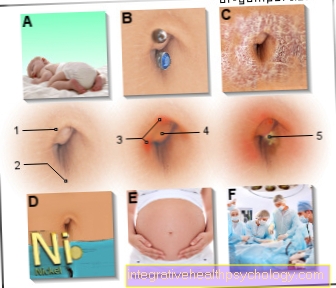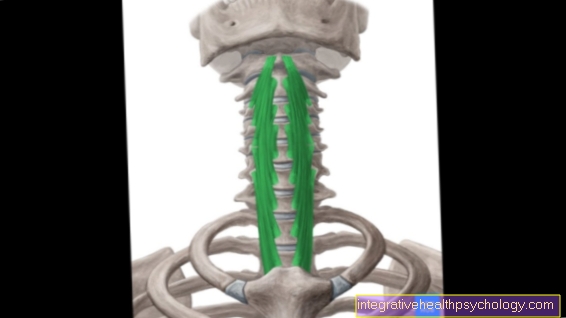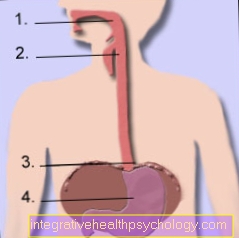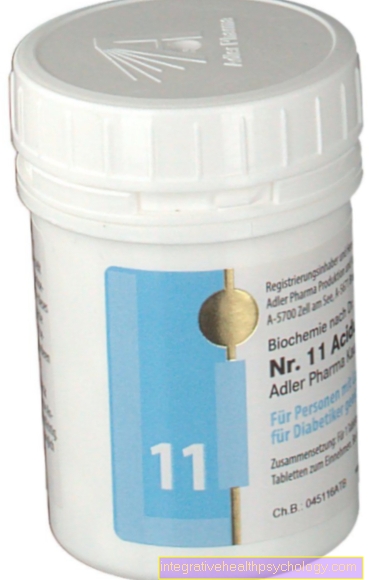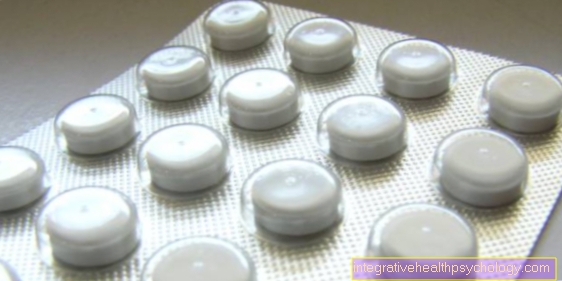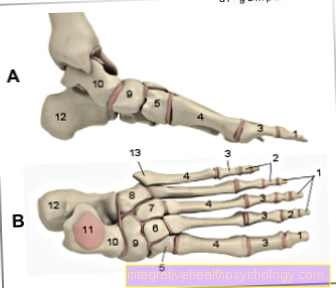Alveolitis sicca
introduction
Alveolitis sicca, or dry alveolus, is a postoperative complication after tooth extraction. In English it is called dry socket designated. It often occurs in the posterior region

Anatomical background
Each tooth is attached to the bone with fibers in an alveolus, a tooth socket of the jaw process. After the extraction, i.e. the removal of the tooth, a free bony space is created that fills with blood. This clot of blood is called a coagulum. This has an important role in healing the defect. The coagulum closes the bone wound and protects it alveolus from invading bacteria. It is therefore the best wound dressing. Later, when capillaries have grown in, it is converted into connective tissue. This is the normal course after surgery with no complications
Symptoms
Alveoltitis sicca is noticeable through:
- severe pain that increases at night
- an anemic alveolus
- Bad breath
- Pus formation in the area of the wound
therapy
If the symptoms mentioned above occur, it is imperative that you consult your doctor. He will examine the wound and initiate the first treatment steps.
In an extreme case, the patient is given a local anesthetic in order to survive the painful procedure. Dead tissue is removed with special instruments and the alveolus is scraped out. This creates a new wound surface that can heal again.
In the next step, a tamponade is made. This bandage is soaked with disinfecting drugs to kill the bacteria that have entered, and pain relievers. The tamponade must be changed regularly by the dentist.
Dentisolon ointment strips are currently common in Germany. Depot tamponades can remain on the wound for a long time.
Another option is to insert an absorbable paste directly into the alveolus using a cannula. One possible paste is Socketol. This consists of the components lidocaine, phenoxyethanol, thymol and balsam of Peru.
When using a paste, there is no need to change the carrier strip. A supplementary dose of antibiotics is not carried out as this has no effect. If there is only a milder case, this would include, among other things, if the alveolitis sicca is already subsiding, careful cleaning and rinsing of the wound area is often sufficient.
It is also possible to rinse the alveolus with 3% hydrogen peroxide and oxygen. A procedure as just mentioned is not indicated in this case, since a renewed scratching would again disrupt the wound healing that has already started and thus the regeneration would rather be delayed. An older method of treatment was drug inserts with zinc oxide cement on a strip of gauze that was left on the wound for a week. The treatment of alveolitis sicca can take several weeks, depending on the severity, so that patience and cooperation is required from the patient.
In the course of the treatment, the mucous membrane grows more and more over the wound until it is finally completely closed again.
antibiotic
The administration of antibiotics in acute alveolitis sicca is controversially discussed in dentistry, since the additional administration of antibiotics in the acute stage of alveolitis sicca does not necessarily contribute to faster wound healing. If there is a massive infection, in the context of alveolitis sicca, then the administration of an antibiotic makes sense to prevent the infection from spreading and the development of sepsis (blood poisoning).
In patients with a tendency to blood clotting disorders or a known tendency to develop alveolitis sicca, the prophylactic administration of antibiotics before tooth extraction is to be regarded as useful. The antibiotics from the group of penicillins have proven to be effective. However, it is not advisable to give antibiotics too frequently or too briefly, as there is a risk of resistance to certain antibiotic groups. Taking chlorhexidine solutions (Chlorhexamed forte®) before and after tooth extraction is one way of reducing the occurrence of alveolitis sicca.
Read more on the topic: Chlorhexamed forte®
Healing time
The healing of alveolitis sicca usually takes about 7-10 days with the right treatment, but it can take several weeks.
Rinses that have a disinfecting effect can be used as a support. The tamponade must be changed regularly by the dentist to prevent re-infection. The wound should then grow closed over time. In most cases, the pain is already relieved after the first treatment, but this does not mean that it has healed immediately. Complete healing takes time and the doctor's instructions must be followed in any case.
Alveolitis sicca and smoking
When a tooth is extracted, a larger open wound is created that has to heal in peace. Smoking should be avoided during this time, as the nicotine supplied can lead to wound healing disorders.
The healing process can take longer or the wound can become infected. Nicotine causes blood flow to deteriorate. If you have been smoking for a long time, the risk of getting alveolitis sicca is increased, as there is generally poorer blood circulation in the tissue.
Wound healing is worsened because the gums that previously surrounded the tooth can die. In addition to nicotine, there are other substances in a cigarette that are inhaled and thus contaminate the wound. It is particularly harmful if you smoke directly after the operation or if you have alveolitis sicca.
The dirty components lead to inflammation, suppuration and also to tissue death.
The first few days you should definitely not smoke to prevent alveoltis sicca.After the primary wound has healed, it is less of a problem, but the safest option is to wait for the wound to heal completely.
causes
The probability of getting alveolitis sicca is between 1 and 4 percent. Once a tooth has been removed, the wound usually fills with blood, which forms a blood clot as it heals.
This protects the wound from bacteria, viruses and fungi until the mucous membrane has grown over the wound.
This is exactly what does not happen with alveolitis sicca. In the course of the "healing", no "blood plug" forms or an existing one disintegrates again. Excessive flushing can also remove the protective blood plug. The hole is therefore not protected and food particles collect in it. In addition, the bones and nerves are exposed.
This is the start of the inflammation, as bacteria can enter unhindered and irritate the bones and nerves.
course
The first pain occurs 3-4 days after the operation and can last for several weeks. From the moment the pain begins to appear, it is advisable to see a dentist. Once the treatment has started, this can take up to several weeks until the mucous membrane has completely grown over the wound. If left untreated, the inflammation worsens. It can develop pus or even an abscess. An abscess describes an encapsulated cavity filled with pus.
prophylaxis
To avoid postoperative pain and the formation of a dry socket, an oil-containing calcium hydroxide paste was developed with which the socket should be filled after each extraction of a tooth. However, since the vast majority of tooth removals proceed without complications, this treatment method did not catch on. After the operation, care should be taken not to rinse too vigorously with the prescribed mouthwash solutions. This prevents the freshly formed blood plug from being removed.
Summary
In summary it can be said. Alveolitis sicca is a painful complication after tooth extraction. It is caused by the breakdown of the blood clot, causing the bone to be exposed. Therapy consists of a thorough revision of the wound and subsequent tamponade of the alveolus. This promotes pain relief and wound healing.
The duration of therapy and complete healing are very different in individual cases.








-mit-skoliose.jpg)

